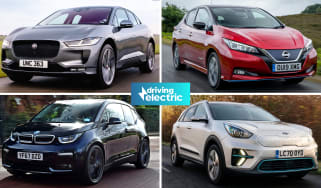Hyundai Ioniq Electric (2016-2022) review
A mid-life facelift gave the Hyundai Ioniq Electric more range, more power and a new infotainment screen, so it's still a strong contender in the family electric-car class
Pros
- Well equipped
- Practical family car
- Efficient powertrain
Cons
- Poor visibility
- Uninvolving to drive
- Might soon look out of date
| Car type | Official range | Wallbox charge time | Rapid charge time |
|---|---|---|---|
| Electric | 193 miles | 6hrs 5mins (0-100%, 7kW) | 47mins (0-80%, 50kW) |
The Hyundai Ioniq Electric was one of the longer-serving electric-car models on the market, on sale from 2016 to 2022. Yet it still holds plenty of appeal. Hyundai kept the car up to date with the latest kit and upgraded the 28kWh battery to a still fairly small 38.3kWh unit in 2019. Despite this small battery, the Ioniq Electric can manage a decent 193 miles on a charge, thanks to an aerodynamically efficient design.
The grille, LED lights and 16-inch alloy wheels all help keep the shape nice and slippery though the air, while special tyres reduce rolling resistance to save precious energy. It's also not a heavy car, at 1,527kg, but it's not exactly a featherweight either. In our experience, the Ioniq Electric does achieve its claimed efficiency, so you can trust the official range figures in all but the coldest climates.
All battery-electric cars are heavily affected by the cold, yet we tested an Ioniq in minus 2.5 degrees Celsius on a mix of city roads and motorways, where it still managed an impressive four miles per kilowatt-hour (kWh) efficiency, for a maximum range of 166 miles on a charge. Given the car's excellent efficiency, we'd expect wallbox charging costs of well under 4p per mile.
There's just one electric motor and it produces 134bhp, which is enough for a 0-62mph time of 9.7 seconds and a top speed of 96mph. The Ioniq doesn't feel fast for the most part, but the initial acceleration from 0-30mph is as punchy as you'd expect in an electric car, so it's great in town. There's a little body roll in corners but it doesn't feel wayward in bends, so it's good to drive. The comfortable suspension means it's as good on rough country roads as it is around town.
The car's point-and-squirt ability is good fun around town, too, and there’s enough performance to overtake with ease at motorway speeds. It’s here that the Ioniq Electric’s four-stage regenerative braking system performs best, allowing you to scrub speed without using the brakes. Hyundai says the highest setting will provide ‘one-pedal’ driving, similar to the Nissan Leaf’s e-Pedal, but in practice it’s not quite strong enough to bring the car to a stop at junctions or roundabouts.
The car’s interior was also overhauled in 2019: a 10.25-inch touchscreen – compatible with Apple CarPlay and Android Auto – is now standard, sitting higher than before to make it easier to read. The instrument cluster behind the wheel is also crystal-clear, and while the touch-sensitive buttons on the centre console can be tricky to use while driving, the infotainment system itself is one of the best we've come across.
Inside, the interior was overhauled: a 10.25-inch touchscreen – compatible with Apple CarPlay and Android Auto – is now standard, sitting higher than before to make it easier to read. The instrument cluster behind the wheel is also crystal-clear, and while the touch-sensitive buttons on the centre console can be tricky to use while driving, the infotainment system itself is one of the best we've come across.
Elsewhere, Hyundai added various active driver assistance systems: high-beam assist, a rear-view monitor, rear parking sensors, smart cruise control and automatic emergency braking (AEB) all make life a little easier behind the wheel, while wireless smartphone charging, keyless entry and heated front seats make for a generous standard kit list. Hyundai’s BlueLink app was thrown in, too; this allows you to monitor charging remotely: you can expect a 50kW public charger to deliver a 0-80% charge in under an hour, while a home wallbox will perform a full top-up in six hours and five minutes.
So did the updates put the Ioniq Electric back at the cutting edge? No – but as an efficient, spacious, comfortable and well equipped car, it does still nail the basics. It poses a serious threat to the Nissan Leaf, and those who can’t afford a Tesla Model 3 should seriously consider it, too. For a more detailed look at the Hyundai Ioniq Electric, read on for the rest of our in-depth review...

